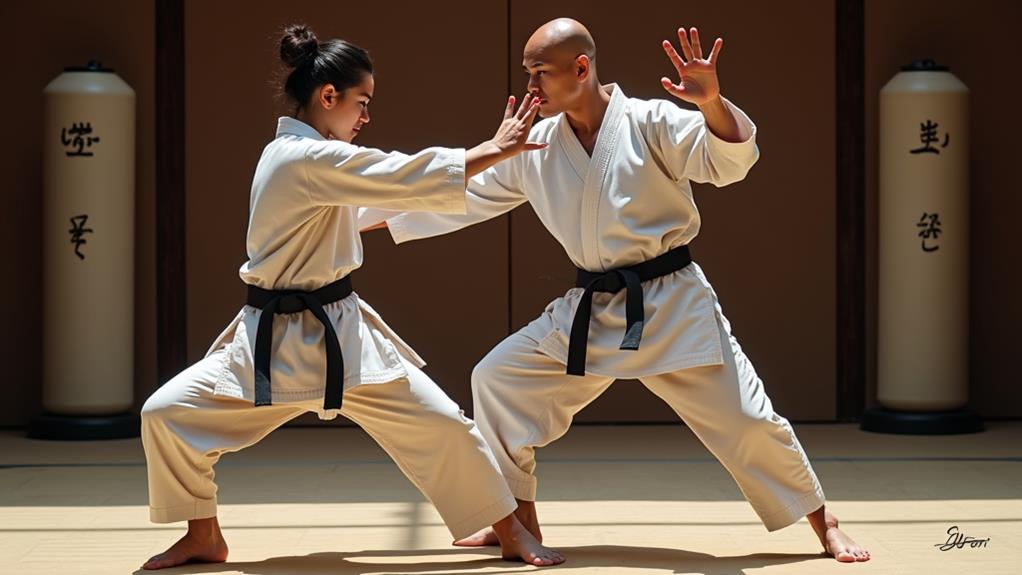You might not realize that the Kubotan, often dismissed as just a keychain accessory, has a rich history rooted in martial arts and self-defense. Its compact design makes it surprisingly effective in various confrontational situations, but effectiveness hinges on more than just having the tool at your disposal. What techniques can truly maximize its potential, and what legal considerations should you keep in mind? Exploring these aspects reveals a deeper understanding of how the Kubotan can be a game-changer in personal safety.
History of the Kubotan
The Kubotan, a small yet powerful self-defense tool, was created by Sōke Takayuki Kubota in the 1960s and quickly gained popularity. Initially designed for training female officers in self-defense, its effectiveness in applying painful locks and pressure point strikes made it a game-changer in personal safety. This keychain weapon, typically 130–150mm (5–6 inches) long, traces its origins back to traditional martial arts weapons like the yawara stick and koppo stick, showcasing a rich history that emphasizes both practicality and combat efficiency.
As you explore the Kubotan's history, you'll recognize how its design allows for discreet carrying while delivering significant impact when needed. However, understanding the legal restrictions surrounding the Kubotan is crucial; laws vary by jurisdiction, with some areas considering it an offensive weapon. This could impact your ability to possess and carry one.
Mastering the Kubotan means respecting not only its capabilities but also the regulations that govern its use. As you dig deeper into its history, you'll appreciate the fusion of martial arts tradition with modern self-defense principles, empowering you to make informed decisions in your self-defense journey.
Techniques and Applications

Mastering Kubotan techniques involves understanding various applications that can be employed in self-defense scenarios. By honing your skills, you'll be prepared to utilize the Kubotan effectively, whether you're a law enforcement officer or an everyday individual seeking safety.
Here are three key techniques to focus on:
- Joint Locks: Use joint locks to gain control over an assailant. This pain compliance technique immobilizes them while minimizing your risk.
- Thrusting Strikes: Deliver thrusting strikes with a backhanded grip for maximum impact. Aim for specific body areas, like the kidneys or throat, to incapacitate an attacker quickly.
- Realistic Scenarios: Train in realistic scenarios that reflect potential self-defense situations. Incorporating defensive and offensive moves during practice will build your confidence and muscle memory.
Remember that proper training in martial arts enhances your ability to perform these techniques with precision. Always prioritize safety precautions to protect yourself and others during training. With dedication, you'll master the Kubotan and enhance your self-defense capabilities significantly.
Legal Considerations

Understanding the legal implications of carrying a Kubotan is just as important as mastering the techniques for self-defense. While a Kubotan can be used effectively for self-defense purposes, you must recognize that it may be classified as an offensive weapon under certain legal jurisdictions. In the UK, for instance, the classification depends on specific situations, which means context is vital.
If you're considering carrying a Kubotan, be aware of the potential legal ramifications. The 2010 Darren Day case, where he was convicted for possessing a kubotan-style keyring in Edinburgh, highlights the importance of understanding local laws. It's crucial to know that air travelers in the U.S. cannot carry kubotans as part of their carry-on items, as they are deemed prohibited items by the TSA.
Always research the laws in your area, as they can vary significantly. This ensures that you're prepared not just concerning physical defense but also legally. Mastery in self-defense includes being informed about the legal landscape surrounding the tools you choose to carry.
Comparison With Other Weapons

When comparing a Kubotan to other self-defense weapons, it's clear that each tool has its unique strengths and weaknesses. Unlike brass knuckles, which deliver powerful punches but limit your hand techniques, Kubotans excel in versatility. Their design allows for effective pressure point strikes and joint locks, making them suitable for various self-defense scenarios.
Here's a quick comparison:
- Brass Knuckles: Powerful but restrictive; they focus solely on punching.
- Pocket Knives: Offer potential lethal force but often come with legal restrictions that may limit their carry options.
- Trench Knives: Designed for close-quarters combat, yet they lack the compact portability of Kubotans.
Kubotans stand out as a discreet option that provides both carrying advantages and legal safety. When you wield a Kubotan, you possess an effective self-defense tool that allows you to strike while also maintaining the ability to control your attacker through joint locks. Unlike more lethal weapons, the Kubotan offers a proactive yet less aggressive approach to self-defense, making it an appealing choice for those seeking to master their skills without the risks associated with more dangerous alternatives.
Limitations and Risks

While Kubotans are effective self-defense tools, they come with notable limitations and risks that users should be aware of. One significant risk is the potential for hand injuries resulting from improper use. When wielded like a roll of quarters, the concentrated force can lead to unintended damage to your own hand. It is vital to grasp the Kubotan correctly to inflict pain and create opportunities for follow-up strikes effectively.
Furthermore, safety precautions are paramount. Understanding the limitations of your Kubotan can help minimize the risk of injury during a confrontation. Regular maintenance ensures that your tool remains efficient in delivering force to specific areas during defensive encounters. If you find yourself in a challenging situation, discarding the Kubotan might become a tactical decision, highlighting the necessity for strategic thinking and adaptability.
Always remember that while the Kubotan can be a potent self-defense asset, its effectiveness relies heavily on your technique and awareness of its risks. Mastery involves recognizing these limitations and preparing yourself both mentally and physically for self-defense scenarios.
Training Recommendations

To effectively master the use of a Kubotan, you should regularly seek guidance from experienced instructors who can teach you the proper techniques and skills important for self-defense. Engaging in thorough training programs not only develops your ability to execute defensive and offensive moves but also enhances your understanding of technique details.
Here are some key training recommendations:
- Incorporate Realistic Scenarios: Guarantee your training sessions include realistic scenarios that challenge your adaptability and response under pressure. This will help you effectively apply your skills in real-life situations.
- Commit to Regular Practice: Consistency is vital. Regular practice allows you to refine your techniques, build muscle memory, and develop confidence in your Kubotan self-defense abilities.
- Prioritize Safety: Always prioritize safety during training to minimize hand injury risks. Use appropriate equipment and techniques to ensure you're prepared for best performance in self-defense situations.
Practical Uses in Self-Defense

Kubotans serve multiple practical purposes in self-defense, making them invaluable tools for personal protection. You can use a kubotan effectively to strike sensitive areas, targeting pressure points and bones to inflict pain and create openings for follow-up strikes. This striking capability not only disorients attackers but also allows you to maintain distance in confrontational situations.
With proper training, you can master wrist locks, which enhance your defensive capabilities and provide control over an assailant. The kubotan's compact and concealable nature means you can carry it discreetly, ready for action whenever needed. This versatility makes it an ideal self-defense tool for everyday carry and travel.
Moreover, you can employ kubotans to assist in throws or assist with clothing grabs, further increasing your options in self-defense scenarios. By honing your skills with this tool, you amplify your confidence and readiness to respond to threats. Remember, the kubotan isn't just a weapon; it's a means to empower yourself, allowing you to protect your safety effectively and intelligently.
DIY and Customization Options

Exploring DIY and customization options for kubotans can enhance your self-defense experience even further. By creating a DIY kubaton, you can design personalized self-defense tools that reflect your unique preferences and needs. This approach not only allows for creativity but also saves you money, making it a cost-effective solution for those seeking tailored protection.
Here are three ways to customize your kubaton:
- Material Selection: Use household items like pens or dowels, or invest in crafting tools to create a sturdy and comfortable grip that suits your hand size.
- Design Personalization: Incorporate colors, patterns, or even engravings that resonate with your style, ensuring your kubaton is both functional and visually appealing.
- Functional Features: Consider adding elements like a keychain attachment or a flashlight to enhance usability, making your kubaton an all-in-one self-defense tool.
Conclusion
To sum up, the Kubotan can be a powerful ally in your self-defense toolkit, much like a well-timed punchline that catches everyone off guard. With its compact design and versatility, it empowers you to respond effectively in various situations. By understanding its techniques and practicing regularly, you can wield it confidently. Remember, the key to success lies not just in having a Kubotan, but in knowing how to use it when it matters most.




